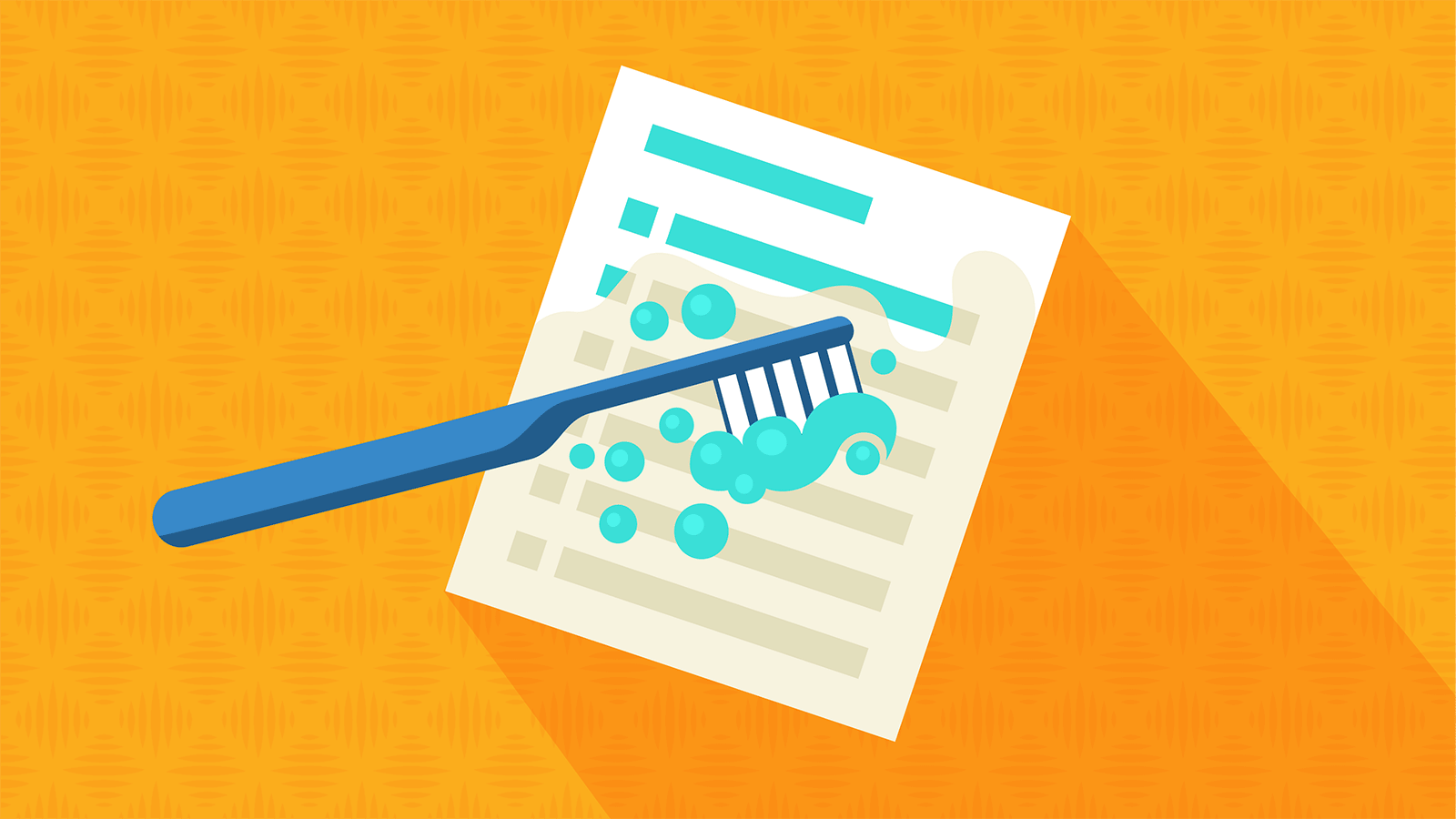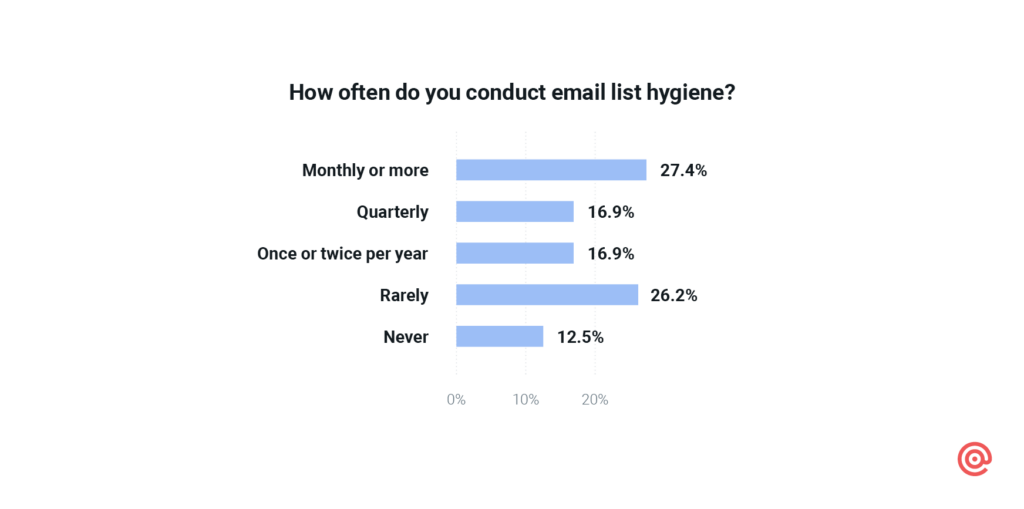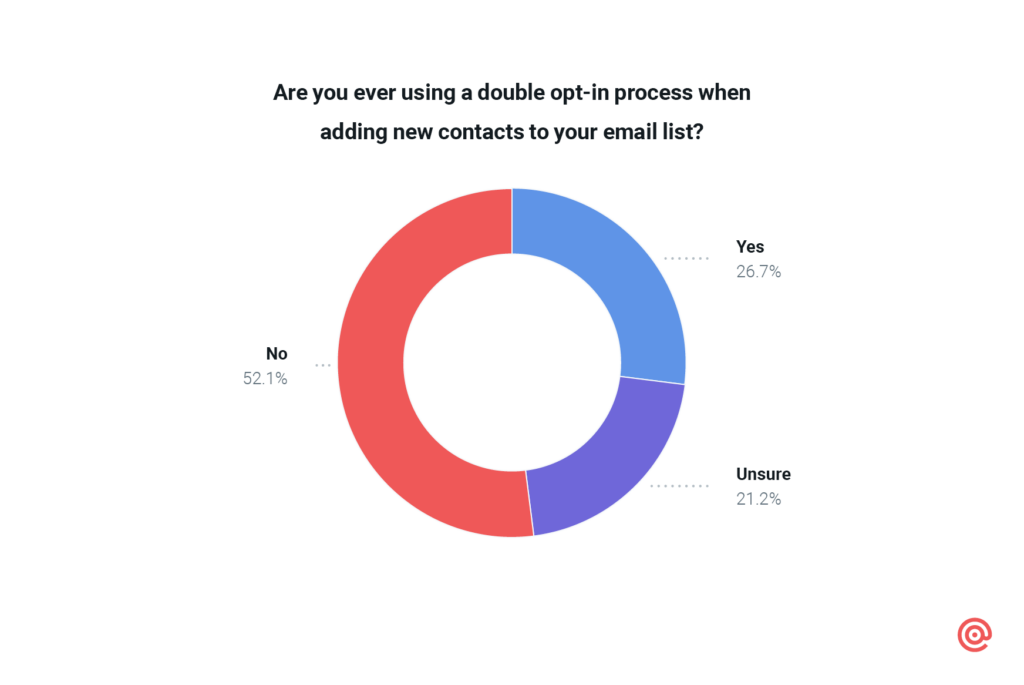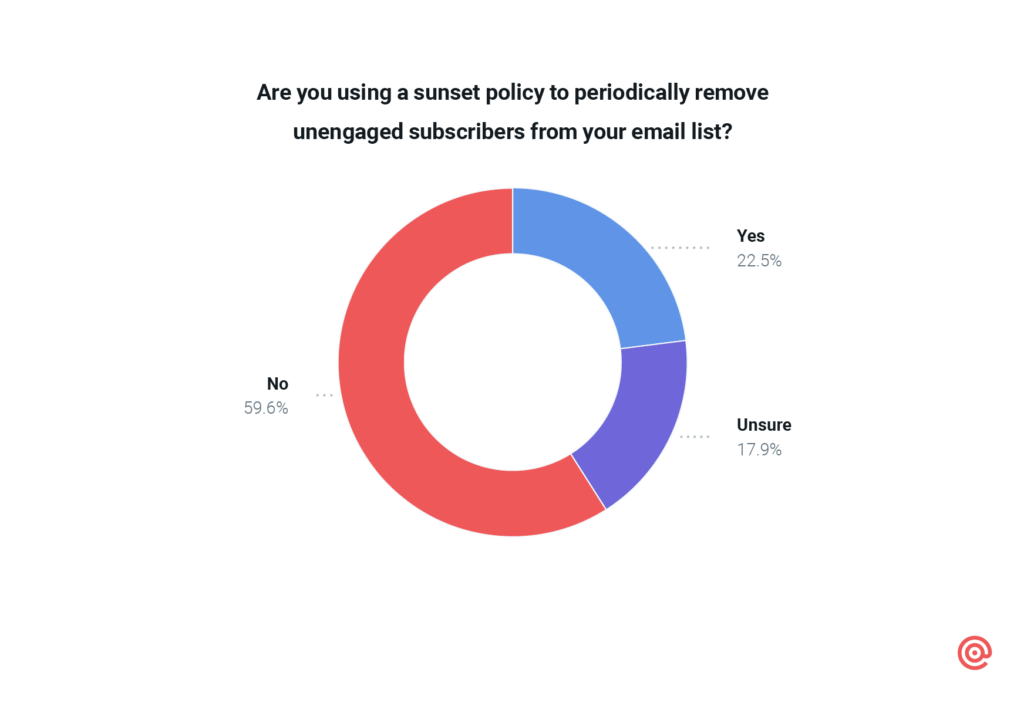Email Deliverability
Email List Cleaning Best Practices to Improve Your Deliverability

Email Deliverability

You know that feeling when you visit the dentist and the hygienist asks you how often you floss? That’s the kind of feeling some email senders get when they’re asked about email list cleaning.
Good list hygiene is important. It supports email deliverability as well as better, more accurate email engagement rates. Invalid email addresses and outdated, unengaged contacts are like stuff stuck between your teeth. But instead of getting cavities, your inbox placement and email performance metrics will suffer.å
We know email marketers are faced with what feels like a never-ending amount of work. But trust us… Email list hygiene makes a difference. In this article, we’ll talk through why email list cleaning is important, how to do it right, and a few steps to take if you need to improve your deliverability.
Email list hygiene is the practice of managing your email list so that you’re only sending to valid and engaged email addresses. Outdated and invalid contacts are removed. Subscribers who haven’t engaged in awhile can be segmented to a separate list with a lower send frequency or targeted with a reengagement campaign.
Periodic email list cleaning (sometimes called “scrubbing your list”) is part of conducting list hygiene. But good email hygiene also means you’re ensuring your list is always in good shape. Think of it like the difference between flossing right before your dental appointment and flossing regularly.
It’s mainly spammers and irresponsible senders using questionable list building practices that find their lists need scrubbing. We’re here to explain how to
It’s the best way to maintain your engagement and deliverability for your email marketing program, but it’s often an overlooked part of your overarching email marketing strategy.
Your best asset in your email marketing program isn’t fancy coding techniques or eye-catching email designs (though those are both great to have.) It’s your email list.
These are the people who said, “yes please!” to hearing more from you. They’re the ones clicking and buying. Without an email list that contains subscribers who want to hear what you have to say, then you’re just wasting all that time and energy. Refusing to remove (or segment) unengaged subscribers just because they signed up year ago hurts your deliverability in the long run. A clean email list is a more engaged, more high-performing one.
But there are other reasons to clean your list, too. The average mailing list depreciates by about 22% a year because people switch mailbox service providers, change jobs, leave school, and ultimately abandon old email addresses.
You may have accidentally collected a bunch of invalid email addresses, either through typos (like “gmial” instead of “gmail”), fake addresses, or abandoned accounts. If you’re working in the B2B world, you may have outdated contacts from layoffs or job changes.
Remember, quality matters more than quantity. Cleaning your list regularly to keep your spam complaints, bounce rates, and unsubscribes down. At the same time, keep your deliverability rate, click-through rate, conversion rate, and open rate high.
The real reason to conduct regular email list cleaning? Not doing so can put your email deliverability at risk. Sending daily or weekly emails to inactive subscribers reflects poorly on your sender reputation and it invites spam complaints. Plus, the failure to remove outdated contacts could lead to potential spam traps in your database. Sometimes mailbox providers use fake or abandoned email addresses as a way to catch spammers. These are known as recycled spam traps.
When you’ve got a dirty email list containing spam traps and unengaged subscribers, it has a negative impact how mailbox providers view your reputation as a sender. If thing get bad enough, you could land on an email blocklist, which means your messages get rejected until you take all the necessary steps to get delisted.
Some senders ignore email list cleaning, which is a huge mistake. According to Mailgun’s State of Email Deliverability survey, a combined 38.7% of senders in the survey rarely or never conduct list hygiene.

Just over a quarter of respondents cleaned their list on a monthly basis, which is a great habit. We recommend at least twice a year, if possible. That’s if you’re following good list building and segmentation practices throughout the year.
There are, however, a few other situations in which it’s a good idea to clean your email list:
Switching your email service provider (ESP), customer relationship management software (CRM), or customer data platform (CDP) comes down to data. It’s a great opportunity to clean your list and make sure you’re porting over only the contacts that actually want to be part of your list to your new email database. It’s also a good time to create a reactivation campaign.
And before you gather your data with a CDP, you’ll want to ensure that you maintain updated and accurate data. Whether you’re new to your role and inheriting a bunch of data sources that need to be organized, or you’re ready to discover new segments, build models, and deliver real-time personalization, cleaning your list should be high up on your to-do list.
Any time you gather new email addresses, it’s crucial to verify those contacts to make sure they are legitimate. Here are some reasons you may suddenly get a bunch of new email subscribers:
There are so many questions that you may not have the answers to, like “how did these emails come to the list?” “Are they purchased?” “When was the last time the list was cleaned?” “Is this a bulk email list with disengaged subscribers?”
Whether it’s from a shared list after a partner marketing event, a new role within your company, or after going through a merger, make sure you evaluate your list. (This is also where we repeat a crucial piece of email marketing advice: Don’t purchase an email list. Ever.)
The best way to answer these questions is to clean your list to verify valid email contacts before you send them any messages.
There are two kinds of email bounces to watch out for in your deliverability metrics: Soft bounces and hard bounces. Soft bounces happen because of a temporary issue, such as a downed server or full mailbox, while hard bounces happen because of a permanent issue, like an invalid email address. Both can impact your deliverability.
If you’re seeing repeated soft bounces from the same few email addresses, suppress them for a few weeks and try again. But you should remove any hard bounces as soon as they happen from your email list to prevent a ding on your sender reputation and deliverability. That’s because hard bounces indicate issues with your contact data and may mean you have too many invalid email addresses on your list.
Uh-oh! This can be a nasty one. One reason why you should clear your lists is to avoid spam complaints. If your audience doesn’t want your email campaigns and doesn’t see an obvious unsubscribe button, they might report you as spam.
That’s why proactive list hygiene is needed. You remove people who haven’t opened and clicked in many months to avoid the possibility that they’ll get fed up and mark your message as spam.
Gmail and Yahoo have a 0.1% spam complaint threshold before you’ll start getting filtered into junk. If you’re finding your user-report complaint rate inching up past that, email list cleaning is one step you can take.
Sometimes, bots fill out email sign-up forms, and you don’t want bots on your list. You’ve probably got an entire team taking care of your business’s cybersecurity issues, but if you have an unprotected input form, you might be in a bit of a bind.
To ensure that you’re only getting real leads or subscribers through your web forms rather than bad emails, disposable or fake email addresses, spam traps, or typos, you need to put a real-time email validation in place. This will not only help decrease the fraudulent or inaccurate data attacking your forms, but it will also protect your deliverability and sender reputation. Most importantly, cleaning your mailing list will improve your email marketing campaign ROI and create a better customer experience.
If your open or click rates are consistently low, then it may be time to clean your email list. You know what drags down engagement rates? Unengaged contacts. When you remove or segment those subscribers, suddenly, your email marketing analytics look a lot better. That’s because you got rid of the dead weight that was dragging your metrics down.
Keep in mind, low engagement rates may suggest a bigger deliverability issue at play here. If more emails are landing in spam than the main inbox, your email open rates and clicks will decline too. That’s why a noticeable change in email engagement may indicate inbox placement issues.
Keeping your email list clean takes dedicated effort, but the positive impact on your deliverability is worth it. Here are a few tools and practices you can use to make your email list hygiene a little easier:
More than 50% of senders aren’t using double opt-in, according to Sinch Mailgun’s State of Email Deliverability report. We get it… Who wants to add friction to an acquisition process that’s already an uphill battle? But it’s always better to have a well-managed, slightly smaller email list with more engaged subscribers than a sprawling list of potential spam complaints waiting to happen.

While double opt-in takes an extra step compared to single opt-in, it helps limit the number of spam traps, bots, and human error typos in your mailing list. Plus, it ensures new subscribers truly want to join your list, which is helpful for GDPR compliance.
If your subscribers don’t want to hear from you, let them go. You should include a clear unsubscribe link in every email. Gmail and Yahoo now require a one-click unsubscribe option in email headers, so it’s time to get on board with easy unsubscribes. (Find out more about using RFC 5058 for one-click unsubscribes.)
If it hurts too much, then instead of just providing an opt-out option on your subscriber preferences page, provide an “opt down” so your subscribers can choose to stay engaged – just not as engaged as before.
In other words, this means your user can choose to receive fewer communications from you – say once a month instead of once a week. Or, they can choose to keep receiving your quarterly email newsletters but not every single promotion or new product announcement. This keeps your subscribers happy and also helps email marketers to segment their mailing list to send appropriate email campaigns.
Every email list has engaged and unengaged subscribers. What you do with those inactive subscribers is what matters for your deliverability.
Creating a sunset policy is a way to define what unengaged means for your email program and build a plan to slowly phase those subscribers out of receiving emails from you. That may include a re-engagement campaign (see below!) but it’s also about segmenting your list based on who wants to hear from you and their behavior rather than vanity metrics. According to Mailgun’s State of Email Deliverability, almost 60% of senders don’t use a sunset policy – so there’s a lot of room to improve here.

Sending one final email asking subscribers who haven’t opened your email in 90 days to opt-in to your emails can help you clean your email list by engagement and revitalize your metrics.
Keep it straightforward, like this email from Readymag. Rather than wasting space trying to explain all the reasons why they should stay, this email just asks the question, “Do you want to receive emails from us?” Anyone who doesn’t click should be removed from your email list. Your engagement metrics will thank you.
Did you know that on average, up to 15% of email addresses on your list are invalid? Marketing automation is a great way to manage list hygiene and purge invalid, disengaged, or outdated email addresses. Set up rules to automatically segment or remove customers who haven’t engaged for a set time limit or whose addresses have bounced twice or more.
You can also use email validation/verification services to easily identify invalid emails during the opt-in process so those emails never make it to your list and hurt your deliverability in the first place.
Deliverability is one of the most challenging (and technical) aspects of email marketing. But with the deliverability solutions from our friends at Sinch Mailgun, it gets a little easier and a lot clearer.
Mailgun Validate is built to support optimal email list hygiene. Use it to bulk verify your entire list, identifying invalid contacts to remove before you hit send. You can also verify email addresses in real-time using the Mailgun Validate API with your forms to catch invalid contact data at the point of sign up.
For a more comprehensive email deliverability solution that includes email validation, check out Mailgun Optimize. This complete deliverability suite also provides blocklist monitoring, inbox placement reports for spam testing, and more. You can event integrate Mailgun Optimize with Google Postmaster Tools and Microsoft SNDS to monitor your reputation with major providers.
Don’t leave deliverability and good list hygiene to chance. Use the best tools to be sure the job’s done right.